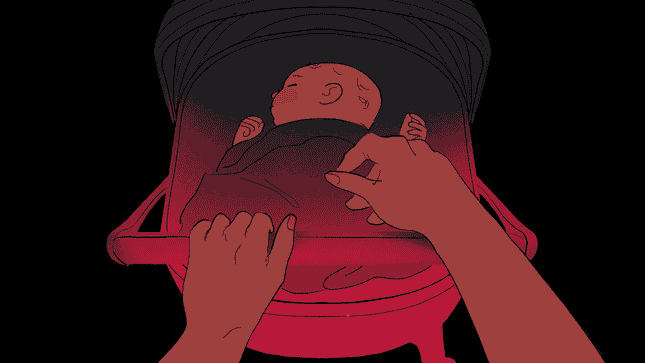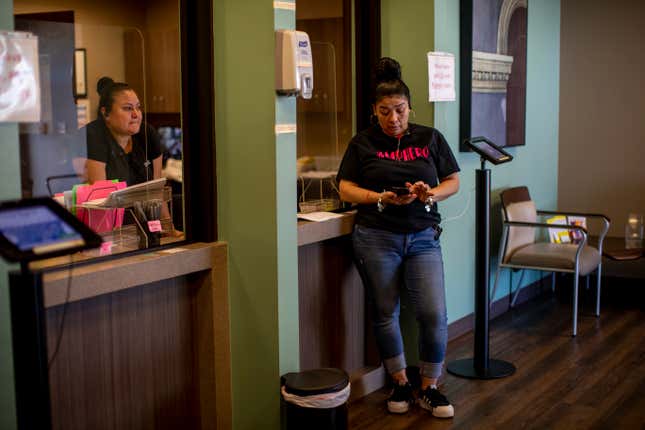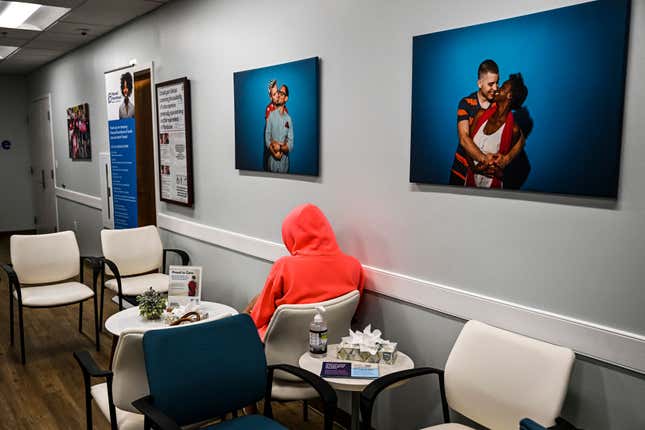The Abortion Stories We Don’t Talk About
A year after Roe was overturned, women who were unable to get abortions are giving birth to babies they weren't prepared to have.
In Depth
Illustration: Vicky Leta
A few weeks ago, a very busy abortion provider in Washington state had open slots on her schedule, and she wasn’t relieved—she was gutted. The independent clinic where Mollie Nisen works has been “incredibly overwhelmed” with patients since the Supreme Court overturned Roe v. Wade one year ago, and the need for abortions hasn’t stopped. She worried these missing patients would be forced to stay pregnant.
“The fact that I’m not seeing them makes me think they’re not getting the care that they need, and that is really scary to me,” Nisen, a family medicine doctor and fellow with Physicians for Reproductive Health, told Jezebel.
She’s thinking about these people all the time—even on the days she’s slammed. On a single day this spring, Nisen did procedures for patients who traveled from seven different states. She’s seen people from Idaho and Alaska and as far away as Texas and Alabama. “Every time I have someone who is able to fly across the country to come see me, I think about all the people who are stuck at home and unable to access those resources.”

But this isn’t even the worst feeling Nisen experiences. No, that’s having to tell some patients who do make it to the exam room that they’re too far along for her to perform an abortion in the state—something that is happening more often post-Dobbs, the case decided last June. “There’s nothing more devastating to me as a provider that is so focused on having people do what is best for them and their families,” she said. “I see the amount of distress this causes. … Continuing with a pregnancy that they’re not connected to is really painful for people.” Nisen can refer them to the few all-trimester abortion clinics in the country, but she never knows if they actually make it. Abortion procedures not only get more expensive later in pregnancy, but people would also need to pay for yet another trip, and take more time off work. You may as well be telling them to fly to the moon.
Women unable to get abortions after Dobbs are giving birth to babies they didn’t want to have, and we’re barely talking about them. I read almost everything about abortion and I can only recall two such stories: That of a 26-year-old Black mother in Jackson, Mississippi, who wasn’t ready to have another child, and a white teen who had twins after Texas’ pre-Dobbs ban halted most abortions in 2021.
What we are hearing are the horror stories trickling out weekly, if not daily, of women across the country who wanted to have children but suffered terrible fetal anomalies or miscarriages, and almost died when hospitals initially denied them the abortions they needed to survive. Media outlets—including Jezebel—cover these cases because they represent the visceral, high-stakes consequences of abortion bans: Pregnancy, whether it’s intentional or not, can be life-threatening and abortion is life-saving healthcare. You know what else is visceral? Not being able to pay your rent because you have a newborn the Supreme Court coerced you into carrying. Stitches on third- and fourth-degree vaginal tears from a baby you didn’t intend to have. And though circumstances like a woman who has three kids and can’t afford more, or simply doesn’t want to be a parent, seem like more “mundane” reasons to seek an abortion, as Nisen called them, any forced pregnancy is a horror story of its own.
The people who are forced to stay pregnant
In just the first nine months after Dobbs, more than 25,000 people were unable to get an abortion from a provider, per reporting from the Society of Family Planning. It’s unclear how many of them remained pregnant against their will or self-managed an abortion. But even if, for argument’s sake, you assumed that half of those people took abortion pills and half gave birth, that’s more than 12,000 Dobbs babies—and counting.
Nisha Verma, an OB/GYN and abortion provider in Georgia, said that, pre-Dobbs, her state used to see a lot of patients traveling from other areas of the South, but now that there’s a six-week ban in effect, she has to turn away even in-state patients every week, often multiple times a week. She can tell patients who are too far along if self-managed abortion is an option and let them know about abortion funds, but it was already so hard for them to get to her clinic in the first place. She recalls a patient from rural Georgia in her early 20s who already had children. Her grandmother came with her to the appointment, but she was beyond six weeks, and Verma had to turn them away. “When they were leaving the clinic, her grandma asked me if I could help them with parking, because they didn’t have money for parking and gas to get home,” she told Jezebel. “Getting out of state can feel just completely overwhelming for people.”
And some of the Dobbs babies come with dangerous complications upon birth. “We’ve had people that come in for their deliveries having been denied an abortion and have a terrible postpartum hemorrhage or develop preeclampsia and are in the hospital for days trying to recover,” said Verma, who’s also a fellow of the American College of Obstetricians and Gynecologists. “It’s not a benign thing for anyone to have a delivery, but particularly for these people that were denied [abortion] care and are being forced into this.”
And these are just the patients she knows were denied abortions at the clinic where she works. In states with abortion bans, half of OB/GYNs said they have prenatal care patients who sought an abortion but weren’t able to get one, according to a new KFF survey; a quarter of OBs nationwide said the same.
Continuing with a pregnancy that they’re not connected to is really painful for people.
Before Dobbs, about 18,000 women lived in U.S. counties more than 300 miles from the closest clinic, Reuters reports. Now, it’s a staggering 16 million. Take a look at any post-Dobbs map of abortion access, and the reason for this jump becomes abundantly clear.
Ashley Brink, the clinic director of Trust Women in Wichita, Kansas, said even though her facility has vastly expanded its capacity, there are still people unable to get abortions—or even appointments. (Trust Women also has an Oklahoma City clinic, but it stopped providing abortions last summer when Oklahoma enacted a statewide trigger ban.) Wichita is, by some counts, the top abortion destination city in the country. The Kansas clinic went from performing about 150 abortions a month before the Texas ban to more than 500 monthly now, and fewer than 100 of those patients are Kansans. Brink increased the staff from five to eight people to 25, but the providers still have to turn patients away who are past Kansas’ gestational limit (22 weeks after the last menstrual period). And many of those women drove eight hours one way to hear this news, she said.
Others never get an appointment in the first place. “We get emails from people who say ‘I’ve tried calling for the last three days and I just can’t get through,’” Brink told Jezebel. “It’s truly first come, first serve and we recognize that there’s also a privilege in that, that not everyone can sit on the phone.” Another problem is that hospitals, especially in Oklahoma, are referring some of those emergency patients to her clinic, which reduces the number of appointments available for people who simply have unintended pregnancies. “I feel very honored that our facility has taken on the challenge to be able to meet the need for these complex cases,” she said. “We take care of them, but it shouldn’t have to be that way.”
If we rarely hear about people who can’t get appointments or who are told ”I’m so sorry” in the clinic exam room, that’s because the people least likely to be able to get abortions for unintended pregnancies have the least privilege to talk about them. Nisen said they are the same groups who had difficulty while Roe was on the books: poor women, Black and brown folks, Indigenous folks, young people, and those who identify as LGBTQ.
“All the barriers that prevent them from getting abortion care are also the barriers that prevent us from hearing their stories,” Nisen said. “I think about the safety of people who are needing or getting abortions, whether that be nonacceptance from their family or communities and their partners, or risk for intimate partner violence.” Some of these people have substance use disorder and are afraid of being criminalized via the healthcare system, while others are afraid of being criminalized for merely seeking abortion in a banned state.

Verma is conducting research on how Georgia’s ban harms people with high-risk pregnancies and said it’s tough finding people who even feel comfortable talking about their experience getting denied an abortion with researchers, let alone reporters. Others don’t have the time, because they’re focused on either trying to get to a clinic, or figuring out how to care for a growing family.
There’s a structural issue, too: It’s harder to cover these stories of robbed autonomy because it means women will need to say they wanted to abort their baby, a child they’re now likely parenting; a person who could find that interview one day.
The unseen harm continues
Once the window for getting an abortion closes, these often unnamed and unheralded people face a ripple of harm affecting not just them, but their children. “Before Dobbs, there were people who were falling through the cracks, and I think now it’s compounded. It’s not a secret to those of us who have been doing this work for a long time that we’re going to see a lot of pregnant people who die in childbirth,” Brink said. And, she added, “we are going to see people who were forced to be pregnant and now economically can’t grow or progress in the life trajectory they saw for themselves.”
Both Verma and Nisen cited the landmark Turnaway Study, which compared women who received abortions with those who were denied abortions and followed them for five years.
“I think about people who are then staying pregnant for 40 weeks and what that is like for them, and not only the toll on their bodies, but their psyches.”
“People denied abortion care that they sought are more likely to be in poverty for long periods of time,” Verma said. “It’s more likely to affect the health of their existing children, they’re more likely to be in abusive relationships, they’re more likely to develop chronic health problems and worsening of serious medical conditions.
Nisen said that “people having access to the reproductive healthcare they need have lower rates of unemployment, less gaps between jobs, more satisfaction with family and work, so it’s so much more beyond just the healthcare aspects.”
She added, “Forcing someone to go through birth and delivery is so deeply unethical on so many levels.”
Some of Nisen’s abortion patients help her understand a fraction of what it’s like for the women she has to turn away, and those who never make it to her. She thinks about the few people who discover their pregnancies before six weeks, so early that providers can’t yet confirm if the pregnancy is in the uterus or ectopic. Medication abortion is slightly less effective for these patients than waiting just a little bit longer—and in Washington, they’ve got weeks to spare. So she’ll tell the patient she can offer the abortion pills now, but they’ll need to follow up with bloodwork to confirm they worked, or they can wait two weeks to get an ultrasound, then take the pills.
“So much more often, for people with a pregnancy that they do not want to continue, even staying pregnant for two more weeks is intolerable to them,” Nisen said. “Then I think about people who are then staying pregnant for 40 weeks and what that is like for them, and not only the toll on their bodies, but their psyches.”
And that toll is, very often, heartbreakingly private.
So yes, it may be a lot easier to be outraged about abortions being denied when, say, a fetus doesn’t have a skull, versus when a woman is unable to end her unintended pregnancy in a clinic like Nisen’s. But the danger is that we’re pitting “good” abortions against “bad” abortions—that is, we’re wading into the “safe, legal, and rare” morass all over again.
“While the people with extraordinary circumstances generate different kinds of empathy, I think it’s also problematic for us to focus on the circumstances,” Nisen said. “The reason does not matter—it’s safe and essential health care.” And people are lacking that care far out of the spotlight. Until we grapple with the fact that these unheard stories of abortions that never happened are also tragedies, we will continue fighting for scraps rather than the full autonomy we deserve.